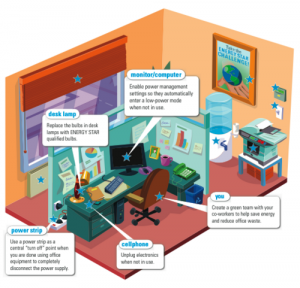deforestation
environment
environment-friendly
global warming
Multiwood
Multiwood Promos
PAPER
pine trees
Save Trees
trees
vegetarian
Water conservation
News
Go Green at Work

Jan 18, 2012

If you’re already taking environmentally friendly steps at home, it’s a natural extension to take similar measures at work, both to save energy and to create a healthier workspace environment. Making the environment more pleasant for yourself, more energy efficient, and more eco-friendly will increase your enjoyment of the workplace and lessen its impact on the environment as a whole.
Being energy and resource efficient and conscious of improving the health and well-being of the work environment will also reduce the costs of running a business. It’s time to “go green” at work, and here is how.
Feel empowered
You don’t need to be management to institute change; your role as someone who cares about improving the energy efficiency and healthiness of your workplace is just as vital as those able to make the “big decisions”. In fact, change from the bottom-up is often a lot more effective as everyone has “buy-in”. And just because you don’t make the purchasing decisions, it doesn’t mean you can’t influence them. Do your research, point out the financial savings to management, and enlist the enthusiasm of your team members too. Find the information, show by doing, and create the momentum, all just because you care.
Conserve your computer’s energy
For many people with desk jobs the computer is absolutely necessary to get things done. Yet, this “efficiency” comes at a cost – it is estimated that people waste over $1 billion in electricity every year just in computer use! To help conserve energy from your computer use, you can:
Invest in an energy-saving computer, monitor and printer – it’s easy to find these computers thanks to the Energy Star label in the USA. The energy savings rating is available in many other countries as well.
Switch to energy-saving settings – the Climate Savers Computing Initiative recommends these power management settings:
Monitor/display sleep: Turn off after 15 minutes or less;
Turn off hard drives/hard disk sleep: 15 minutes or less; and
System standby/sleep: After 30 minutes or less.
Setting the computer to sleep mode when you are away for short periods of time makes good sense. And don’t use a screensaver – these use energy rather than save it, and you are much better off relying on the power management features to power down to lowest energy use, or sleep mode. A computer in sleep mode can save 60-70% of power.
Turn off your computer whenever you’re not using it, especially when leaving work. And note that it isn’t true that turning your computer on and off will wear it out.
Switch to a laptop or a thin client. Laptops and thin clients use less energy than desktop computers.
Turn off all peripherals when not in use
Peripherals such as printers, video cards, speakers, and scanners continue to consume power even when not in use. Unplug them and save energy.
Unplug power adapters when not in use.
Unplug battery chargers and other chargers when the charging is complete, otherwise they are still consuming energy.
Using a power strip as a central turn-off point can reduce the number of switching off actions required.
Reduce printer use
The printer is one of the most used office items. Every day it cranks out tons of important faxes, emails and other documents. Here are some ways you make your printer use greener:
Try not to print in color – learn how to Cut Printing Costs on an Inkjet Color Printer.
Use a printer that does double-sided copying. If your workplace doesn’t have this, request that such a printer be added to the network and designate that one for the big printing jobs.
Print in draft mode. In addition, try to print more screen pages to a paper page. Printing two screen pages per printed page is still very readable and double-sided, that means four screen pages per one paper page – a huge paper savings!
Recycle ink and toner cartridges – learn how to Refill and Reuse a Printer Cartridge.
Try to use a multifunction device. This is a combination of printer/scanner/copier in one. Provided it is Energy Star rated, it can save both energy and space.
Reduce your paper waste
Do you really have to print out every email and handout? Reduce paper waste by deciding to go paperless wherever possible. You can try to:
Keep copies of important emails, files, and more on your computer.
Use old paper with extra space to print small documents.
Don’t get any extra catalogs or magazines mailed to your office. Use a sharing system to pass around interesting materials between everyone’s in-trays. This saves paper and money.
Get your check directly deposited. Payment direct to your bank account saves paper.
Send company updates through email instead of on paper.
Review any documents online instead of printing them out. It’s commonplace to hear people say that they cannot read on the computer screen but it’s a learned skill like most work skills, and with practice, it is possible to read most of your work on-screen and print only when absolutely necessary. If you have problems with eye strain, see your doctor.
Prioritize your paper use
If you do use paper on a daily basis then you can make eco-friendly paper choices. Here are some things you can do:
Buy recycled and chlorine-free paper.
Try paper made from organic products like bamboo, cotton or hemp.
Print on both sides of the paper.
Shred old paper to use as packing material.
Save and reuse old boxes.
Use old sheets of paper for scrap paper or note-taking. Use mistake prints as scribble paper, or send a stack along to your children’s daycare or school for artwork use.
Reduce energy usage
Along with reducing the energy usage of your computer and peripherals, there are a number of broader ways to reduce energy usage in the workplace:
Replace your desk lamp light bulbs and overhead lights (where possible) with compact fluorescent light bulbs qualified with the Energy Star. These bulbs use 75% less energy than incandescent bulbs and last up to 10 times as long.
Turn lights off when nobody is using an office, conference room, your workspace, or the whole office at night. Where the lighting controls are on automatic override, talk to building management about having the settings changed to only use sufficient lighting for security and safety purposes, rather than over-lighting the whole building.
During cold weather, keep blinds open to let the warmth in; during warm weather, keep blinds pulled to close out the heat of the summer sun.
Keep window vents clear of paper or other obstructions, to allow the free flow of air.
Use Energy Star rated programmable thermostats to automatically adjust heating and cooling in the building so as to avoid wasting energy.
Get an Energy Star qualified water cooler. These use half the energy as standard units.
Maintain healthy air flow
It’s already bad enough that you have to worry about air pollution every time you walk outside, but it’s also a big priority when you work inside. If you work in an office, cubicle, or workshop, it’s likely that you’re spending most of your time indoors – a Canadian survey found that people spend over 96% of time at home indoors and over 83% of time at work or school indoors, equaling about 40 or more hours at your desk, office, or cubicle. Here are some ways that you can maintain a healthy air flow in your office:
Use non-toxic cleaning products. Water dampened cloths are sufficient to clean most dusty workspaces.
Open your windows to increase air flow. If you can’t open windows, be sure to take outdoor breaks throughout the day.
Don’t smoke in or near the office.
Never bring any type of aerosol can to work.
Use an air purifier to get rid of contaminants.
Green your desk, cubicle, office… literally
Get a plant and place it on or near your desk. Or, even better, buy plants for all of your neighbors. They will not only see this as a friendly gesture, but they’ll also have cleaner air to breathe! Plants absorb indoor air pollution and increase the flow of oxygen, so get a green accessory to complement your desk!
Recycle
There are many things in your office that you can recycle. If you don’t have a recycling station at work, start one on your own! You can get a few bins and post recycling guidelines above them. Some of them may include recycling:
Paper products like copy paper, envelopes, magazines, etc.
Cardboard boxes from shipped supplies;
Soda cans and plastic bottles;
Aluminum foil;
Plastic bags;
Ink cartridges; and
Edible items





 Chat Now
Chat Now